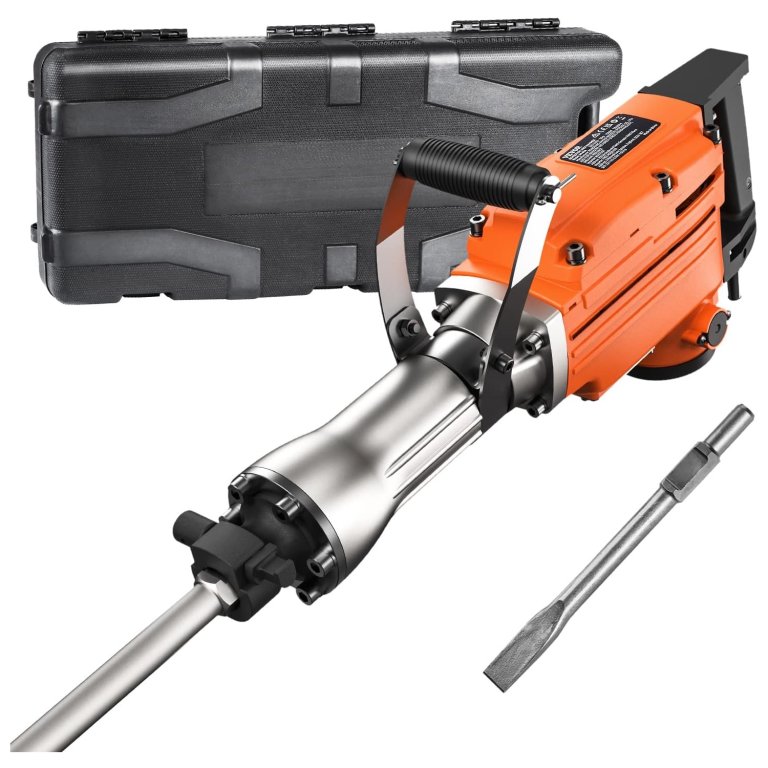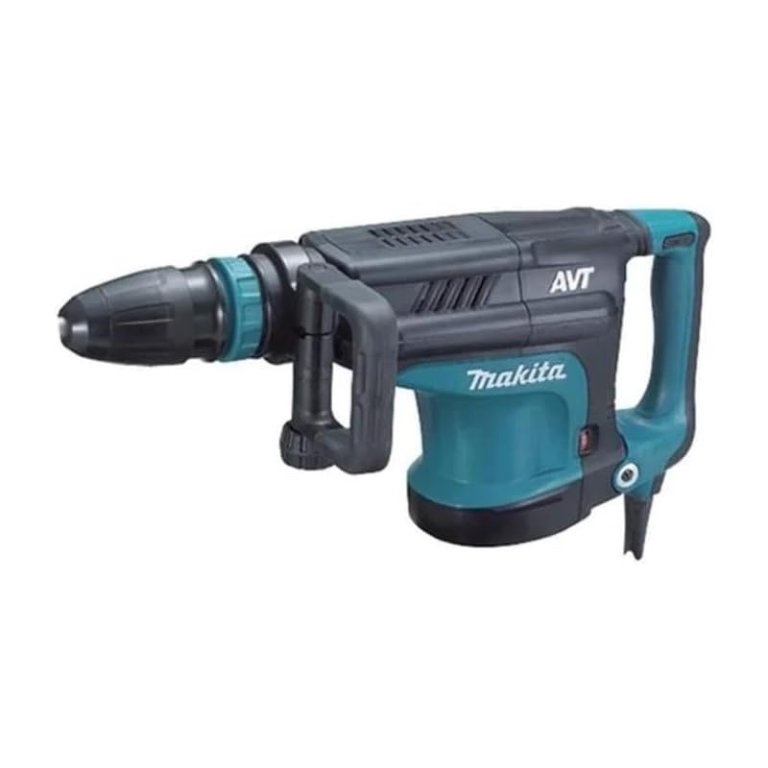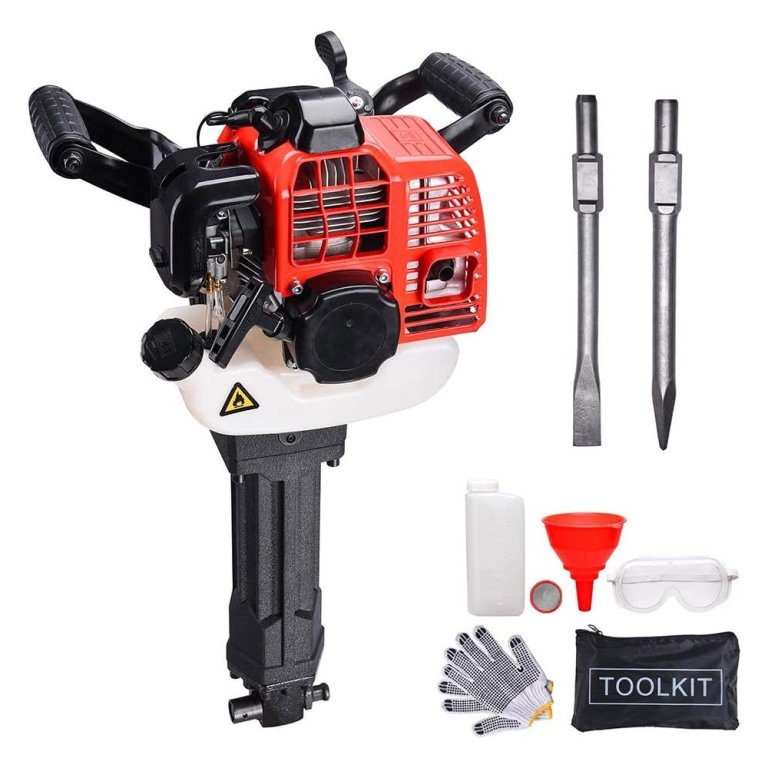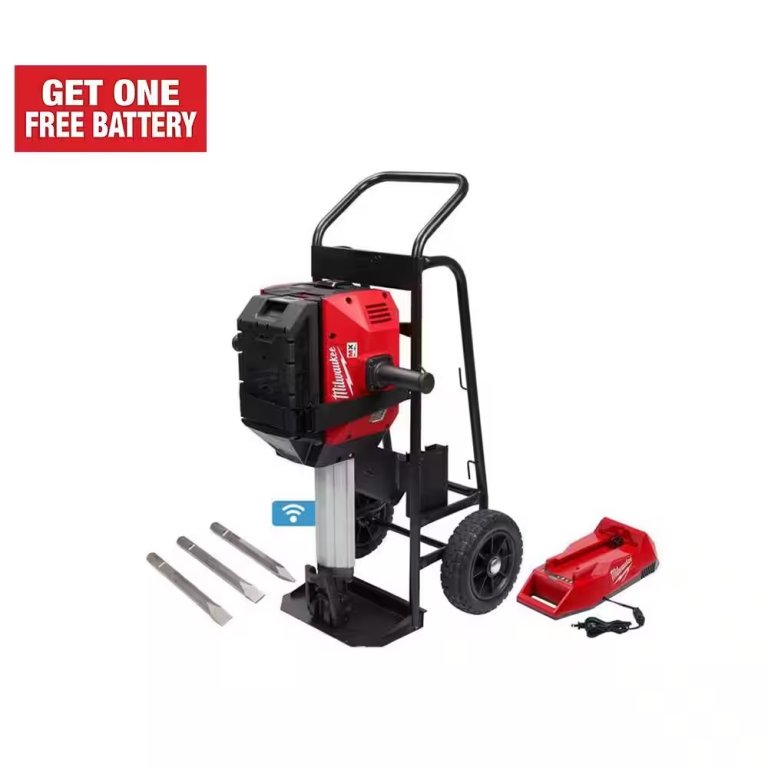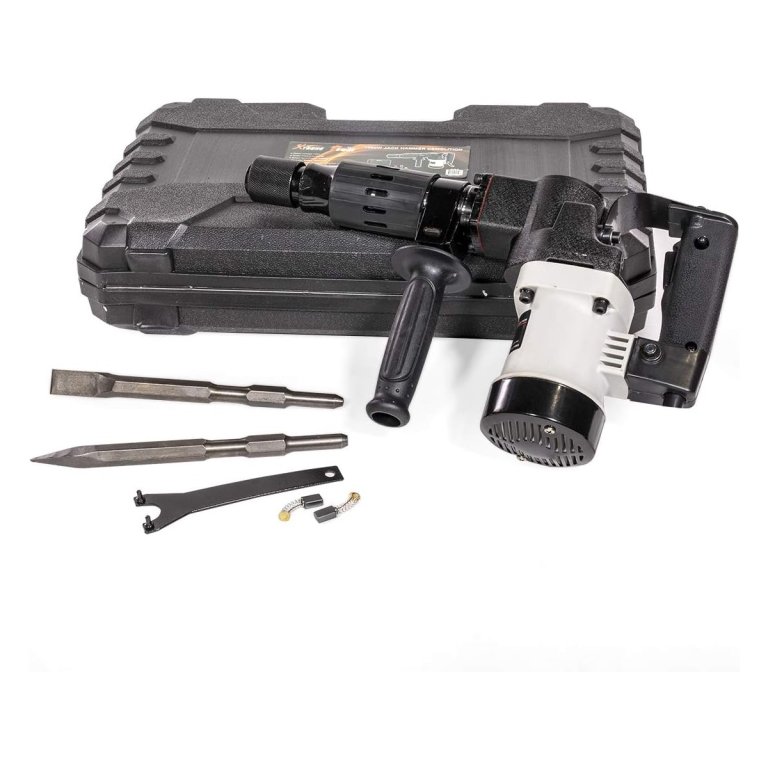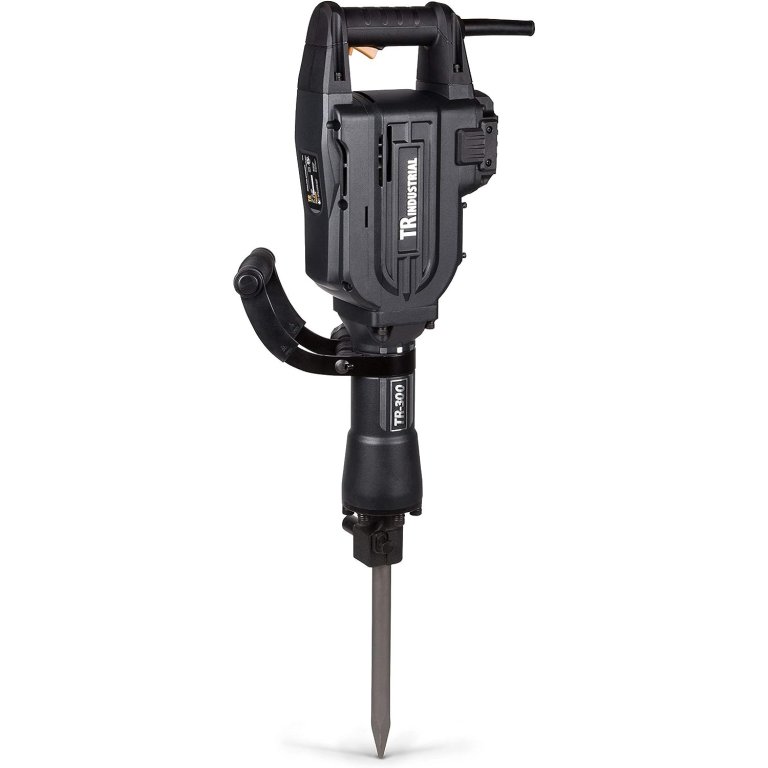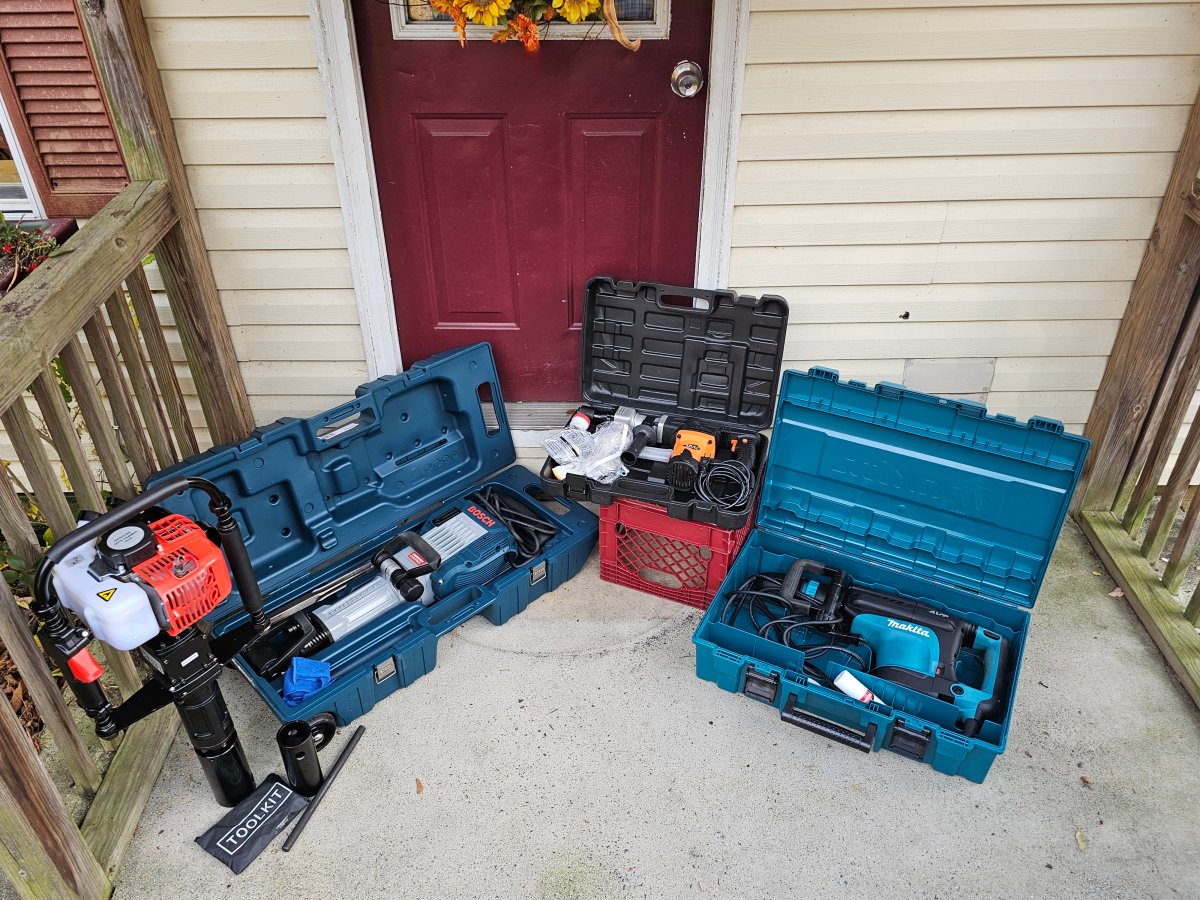
We may earn revenue from the products available on this page and participate in affiliate programs. Learn More ›
When home improvements require demolition—whether removing concrete, asphalt, walls, or tile floors—a jackhammer is the tool of choice. Jackhammers used to be tools that only professionals used, but they now come in a variety of sizes and price points, making them more accessible to everyone. Since so much has changed, we researched more than a dozen jackhammers and tested four to help you find the right one for your next big project. We also selected four additional products to consider, based on their exceptional features.
The Bosch Jack 35-pound 1⅛” Hex Breaker Hammer tops our list for its sheer power and sturdiness. After our tests, we think there isn’t a job that this demolition electric hammer can’t handle. However, the Bosch isn’t the only one we like. This guide includes more top picks for a range of jobs in addition to some important technical and performance issues to consider when shopping. Read on to discover our testing results and find the best jackhammer for your needs.
- BEST OVERALL: Bosch Jack 35-Pound 1⅛-Inch Hex Breaker Hammer
↓ Jump to Review - BEST BANG FOR THE BUCK: Vevor Demolition Jackhammer
↓ Jump to Review - BEST VERSATILITY: Makita 23-Pound SDS‑MAX AVT Demolition Hammer
↓ Jump to Review - BEST GAS-POWERED: Yescom 32.7cc 2-Stroke Gas-Powered Jackhammer
↓ Jump to Review - BEST CORDLESS: Milwaukee MX FUEL Breaker Kit
↓ Jump to Review - BEST HEAVY-DUTY: Makita 70-Pound AVT Breaker Hammer
↓ Jump to Review - BEST LIGHTWEIGHT: XtremepowerUS 3,000bpm 1½-Inch Demolition Hammer
↓ Jump to Review - BEST COMPLETE SET: TR Industrial TR-100 Demolition Jackhammer
↓ Jump to Review
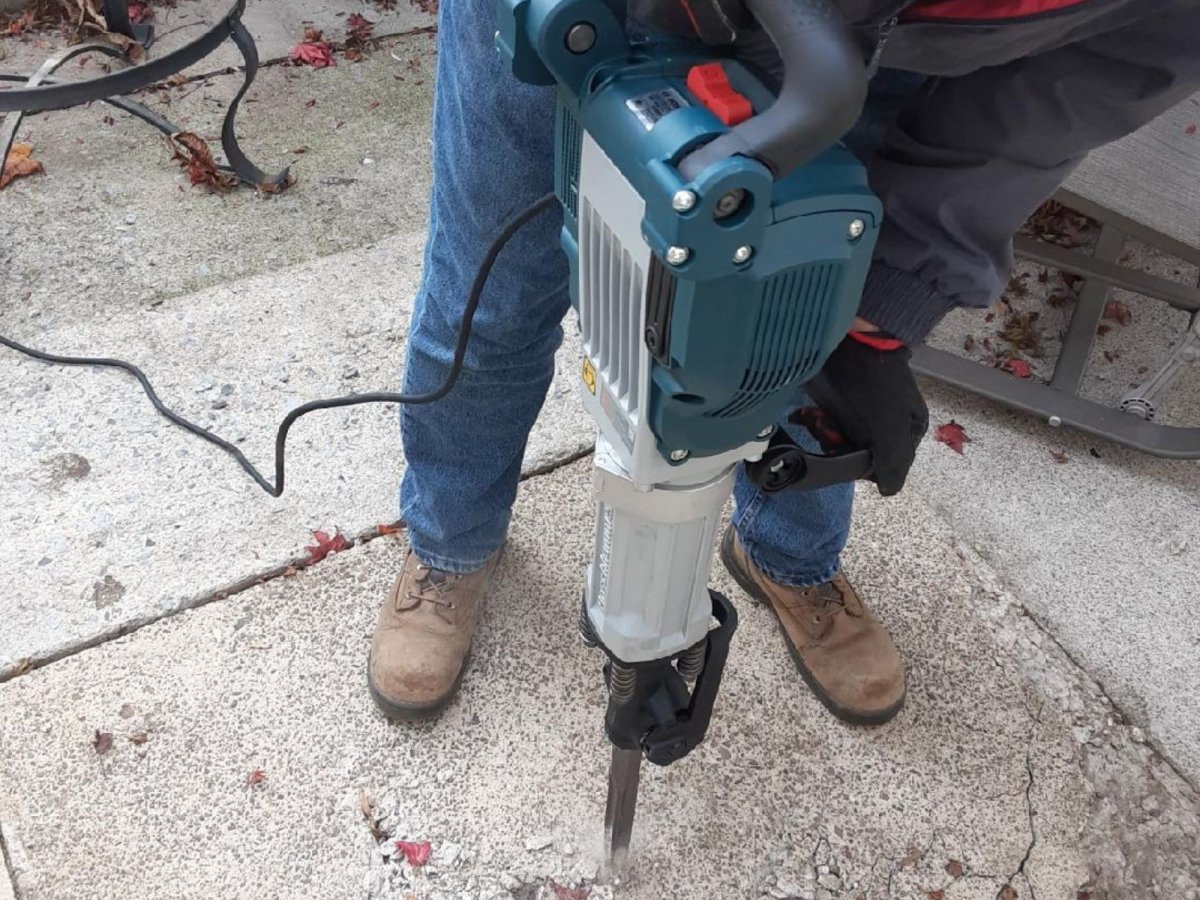
Our Top Picks
Each of the following tools is the best jackhammer in its category. Titles help reflect performance and have been provided so you can quickly focus on the right solution for your needs.
Best Overall
Bosch Jack 35-Pound 1⅛-Inch Hex Breaker Hammer
What We Like
- Powerful enough for larger jobs
- Wheeled storage container increases mobility
- High-quality construction
What We Don’t Like
- Weight affects the ability to control direction
- Too large for smaller users
- Shorter cord; some jobs may require industrial electrical cord
Product Specs
- Power: 15-amp (A); 960 watts
- Impact energy: 22 foot-pounds
- BPM: 1,300
Our Ratings: Setup 5/5; Maneuverability 4/5; Performance 5/5; Build Quality 4.5/5; Value 4.5/5
Although it was one of the heavier tools tested at 38 pounds, we still found the Bosch manageable. In our tests, it broke up material easily with an impact force of 22 foot-pounds and 1,300 blows per minute (bpm). The air-cushioned vibration-control system and shock-absorbing top handle help ease the effect on the operator, but it still may be somewhat jarring, especially for users of smaller stature. One of the best features is the second handle, which can be adjusted at various angles so the user can maintain control in a variety of positions. We also appreciated the sturdy carrying case with wheels to easily transport the jackhammer to the work site.
A well-built tool with a price tag to match, the Bosch is a powerhouse. While it may be more than needed for smaller jobs, it’s well-suited to the needs of contractors or even homeowners who have several demolition jobs on their to-do lists. The Bosch only includes the star point chisel, so it may be necessary to purchase additional bits to expand the use of this hammer.
What our tester says: “When I started this one up I knew it could obliterate anything. It went through concrete, asphalt, everything I threw at it without an effort on my part. I felt like I got the power of an industrial jackhammer without being shaken to pieces.” —John Tropp, independent contractor, Pottsville, PA
Get the Bosch jackhammer at Amazon, Lowe’s, or The Home Depot.
Best Bang For The Buck
Vevor Demolition Jackhammer
What We Like
- Personal safety equipment included
- 2 bits included for expanded use
- Lightweight construction makes handling easier
What We Don’t Like
- Short cord at just 6 feet
- Not powerful enough for larger jobs
Product Specs
- Power: 13A; 1,400 watts
- Impact energy: 14 foot-pounds (19 joules)
- BPM: 2,900
Our Ratings: Setup 5/5; Maneuverability 5/5; Performance 4/5; Build Quality 4.5/5; Value 5/5
When we learned that the Vevor was under $100, we had doubts about how effective it would be, but we were pleasantly surprised with this small jackhammer. We tested it on small sections of concrete, asphalt, and cinder blocks and it managed to break them all, but we wouldn’t turn to this tool for extensive jobs like demolishing an entire driveway.
At just 18 pounds this was a breeze to maneuver, and because it is so lightweight, the Vevor would be an ideal choice when doing indoor or precision work. We feel it would be great for a job such as taking up a tile floor or a small section of a sidewalk. Although it is smaller, we had no problems with the motor overheating and found it easy to switch bits.
The Vevor includes a full kit of accessories, including some personal safety equipment—perfect for those new to home renovations. Along with a flat chisel and point chisel, it also comes with grease, goggles, a dust mask, and gloves.
On the downside, the storage case, which was otherwise adequate, arrived with a broken clip. At this super-affordable price point, however, we’re willing to chalk it up to rough handling during shipping. The cord was on the shorter side but given that this jackhammer is designed for lighter-duty, small jobs, the length is not a major drawback.
For small to medium jobs, the Vevor is a capable, easy-to-handle jackhammer at a great price.
Get the Vevor jackhammer at Amazon or Vevor.
Best Versatility
Makita 23-Pound SDS‑MAX AVT Demolition Hammer
What We Like
- Comfortable grip
- Adjustable handle makes it easy to use at different angles
- Powerful while still retaining maneuverability
- Sturdy storage box
What We Don’t Like
- Only comes with one bit
- Could be challenging for smaller users
Product Specs
- Power: 14A, 1510 watts
- Impact energy: 18.8 foot-pounds
- BPM: 1,900
Our Ratings: Setup 5/5; Maneuverability 4.5/5; Performance 5/5; Build Quality 4.75/5; Value 4.8/5
While the 23-pound Makita only comes with one bit (bull point), we named it the most versatile because it offers the best of both worlds. It handles like a smaller tool, managing to be comfortable to hold and easy to guide with both a rear and adjustable side handle, yet it still has heavy-duty construction and the power for larger jobs.
We witnessed its power when it easily busted up concrete, but when we moved on to testing in asphalt we wanted to see how easy it would be to control. We found that despite the power and force of the Makita we were still able to control it well enough to make a precise line cut.
We were impressed by several extra features. The soft start gives the user better control that can make precision work easier, while the adjustable speeds can be set to match different jobs and materials. It also has a soft no-load function to reduce the motor speed when it is not in use, increasing the lifespan of the tool. The Makita also flashes warning lights when there is a switch or cord problem and when the brushes need to be replaced. It includes a sturdy carrying case. With the additional purchase of SDS-MAX bits, this tool can tackle a wide variety of jobs.
The Makita is an investment, but considering its potential and the extra features, we consider it well worth it for anyone who performs extensive demolition.
Get the Makita jackhammer at Amazon or The Home Depot.
Best Gas-Powered
Yescom 32.7cc 2-Stroke Gas-Powered Jackhammer
What We Like
- Gas-powered motor allows for greater mobility
- Durable construction
- Powerful motor
What We Don’t Like
- Slightly top heavy
- User manual not translated well
Product Specs
- Power: 32.7cc; 900 watts
- Impact Energy: 33 foot-pounds (45 joules)
- BPM: 2,230
Our Ratings: Setup 4/5; Maneuverability 4/5; Performance 4.5/5; Build Quality 4.5/5; Value 4.5/5
An electric jackhammer seems like the perfect tool, but electric tools tether the user to a cord and potentially a generator, depending on the work site. When a job is too far from a power outlet or a cord is too much of a hassle, one option is a gas-powered tool.
We tested the Yescom only for pile driving, as its design intends. Although useful for installing fences and other outdoor structures, this is not for demolition. However, Yescom does offer a gas-powered demo jackhammer with bit attachments if standard demolition is part of the project.
We had no problem driving fencing into dry clay soil because this is a sturdy, powerful machine. It arrives with a tool kit, two socket sleeves, and two piling heads. Weighing in at 34 pounds, it’s a challenge to haul the Yescom into place, and the unit is a bit top-heavy in some positions. This tool will require more maintenance than an electric tool, including keeping a gas-oil mix on hand, but it can go to places out of the reach of corded tools at less cost and with more power than a battery-operated model. We also like that it meets Environmental Protection Agency (EPA) emission requirements, though it does not meet the more strict California Air Resources Board (CARB) standards.
Also, although we give the users’ manual a plus for providing a detailed parts breakdown and the instructions are pretty self-evident, the English translation includes some awkward phrasing to sift through.
Get the Yescom jackhammer at Amazon or Walmart.
More Great Options
There is such a wide range of jackhammers on the market that we couldn’t test them all. But we didn’t want to neglect to introduce you to tools that may be ideal for your needs. After researching additional models, we found that these models also offer many favorable features.
Best Cordless
Milwaukee MX FUEL Breaker Kit
What We Like
- Cordless operation offers mobility and high performance
- Redlink Plus maximizes battery performance
- One-Key compatibility allows digital tracking and management
What We Don’t Like
- More expensive than corded, especially with spare batteries
Product Specs
- Power: 5Ah battery
- Impact energy: 50 foot-pounds
- BPM: 1,300
There are several lightweight cordless jackhammers on the market, but few truly high-performance cordless jackhammers exist, simply because it’s difficult to get sustained high power out of a battery pack. The Milwaukee MX Fuel cordless breaker is an exception. With impact energy of 50 foot-pounds, it is actually the most powerful handheld jackhammer on this list. Its 1,300bpm is competitive, too.
Cordless tools are rated by voltage rather than by amps or watts. Demolition drills are typically 24V, and occasionally 36V. The Milwaukee cordless demolition hammer is a 72V model, which goes some way to explaining the impressive impact statistics. As you would expect from the brand, it is also well made and reliable.
Milwaukee claims this battery-powered jackhammer can move 2 tons of material per charge, though they don’t state what material or conditions. They also say one charge could dig a 40-foot trench that is 1 foot wide and 6 inches deep. Real-world performance may differ, but it still impresses. A recharge time of 90 minutes makes a spare battery something of a necessity for professional use.
Get the Milwaukee jackhammer at The Home Depot, Northern Tool + Equipment, or Acme Tools.
Best Heavy-Duty
Makita 70-Pound AVT Breaker Hammer
What We Like
- Anti-vibration technology improves handling
- Side handles and chunky trigger offer positive grip
- 16.4-foot cord for added reach
- Includes wheeled cart and 4 chisels
What We Don’t Like
- Price will be beyond many home users’ budgets
Product Specs
- Power: 15A; watts not provided
- Impact energy: 46.5 foot-pounds (63 joules)
- BPM: 1,100
Two things are required to maximize destructive force: impact energy and tool weight. That means lighter models, despite having similar performance figures, can’t deliver the outright power that this Makita does. The combination of 46.5 foot-pounds and 71.3 pounds of mass results in faster, more efficient breaking of concrete and asphalt surfaces.
But as we often hear, power is nothing without control. The Makita jackhammer uses proprietary anti-vibration technology with an exclusive counterbalance system so most of the energy goes through the chisel and not the user. Wide side handles also allow for better balance and maneuverability.
On some jackhammers, the cord can be a mere 6 feet, which makes an extension a necessity. The Makita has an extra-long power cord—16.4-feet—so extension will be necessary less often. It also comes with a useful wheeled cart for easier transportation and a selection of four chisels.
Get the Makita jackhammer at Amazon, The Home Depot, or Acme Tools.
Best Lightweight
XtremepowerUS 3,000bpm 1½-Inch Demolition Hammer
What We Like
- Lightweight at under 20 pounds but still useful
- Ideal for tile removal and brick or block wall demolition
- Case holds chisels, wrench, and spare motor brushes
What We Don’t Like
- Some buyers criticized the instruction manual
Product Specs
- Power: 9.1A; 1,000 watts
- Impact energy: 8 foot-pounds
- BPM: 3,000
The XtremepowerUS jackhammer weighs just under 20 pounds, ranking it among the lightest tools in its class. Despite its compact dimensions, it has plenty of performance to offer. The 1,000-watt motor delivers 8 foot-pounds of impact energy and an extremely rapid impact rate of 3,000bpm.
This is a useful tool for concrete breaking, tile removal, and general demolition of brick and block work. The ergonomic D-grip main handle and 360-degree side handle (which can be removed completely if desired) offer easy control and maneuverability. Two ⅝-inch chisels are included, and it comes in a tough blow-molded case. The price will make it very attractive to DIYers and to tradespeople who need a jackhammer only occasionally.
Get the XtremepowerUS jackhammer at Amazon, The Home Depot, or Walmart.
Best Maneuverability
TR Industrial TR-300 Demolition Jackhammer
What We Like
- Includes flat, hex, and spade chisels
- Heavy duty
- Swivel handle
What We Don’t Like
- Some complaints of oil leakage
Product Specs
- Power: 11A; 1,240 watts
- Impact energy: 33 foot-pounds (45 joules)
- BPM: 1,800
The TR Industrial 100 weighs in at 31 pounds and has an impact rate of 1,800bpm. With that power, it can handle challenging jobs. The adjustable handle makes it easier to come at a job from different angles comfortably. In addition to being a durable tool, it comes with everything you need—except ear protection. The case contains the jackhammer, chisels (flat, hex, and spade), oil, safety goggles, gloves, and extra carbon brushes.
This set is priced under $300 but its performance seems to match many more expensive products. Reviewers have described it as “a beast” although there were some comments about minor oil leakage.
Get the TR Industrial jackhammer at Amazon, The Home Depot, or TR Industrial.
Jump to Our Top Picks
How We Chose and Tested the Best Jackhammers
Our review of the best jackhammer includes four that we tested as well as four additional options that we also recommend based on our product research. When selecting the best demolishing hammer for this guide, we considered performance as well as price, durability, and mobility.
Depending on the bits included with each product, we tested the tools by breaking up concrete, asphalt, cinder blocks, bricks, and dirt. During these tests, we observed how easily the task was accomplished, how durable the tool seemed, any motor or design issues, and the effectiveness of safety features. We also considered if a tool would be suitable for a range of jobs if additional bits were purchased.
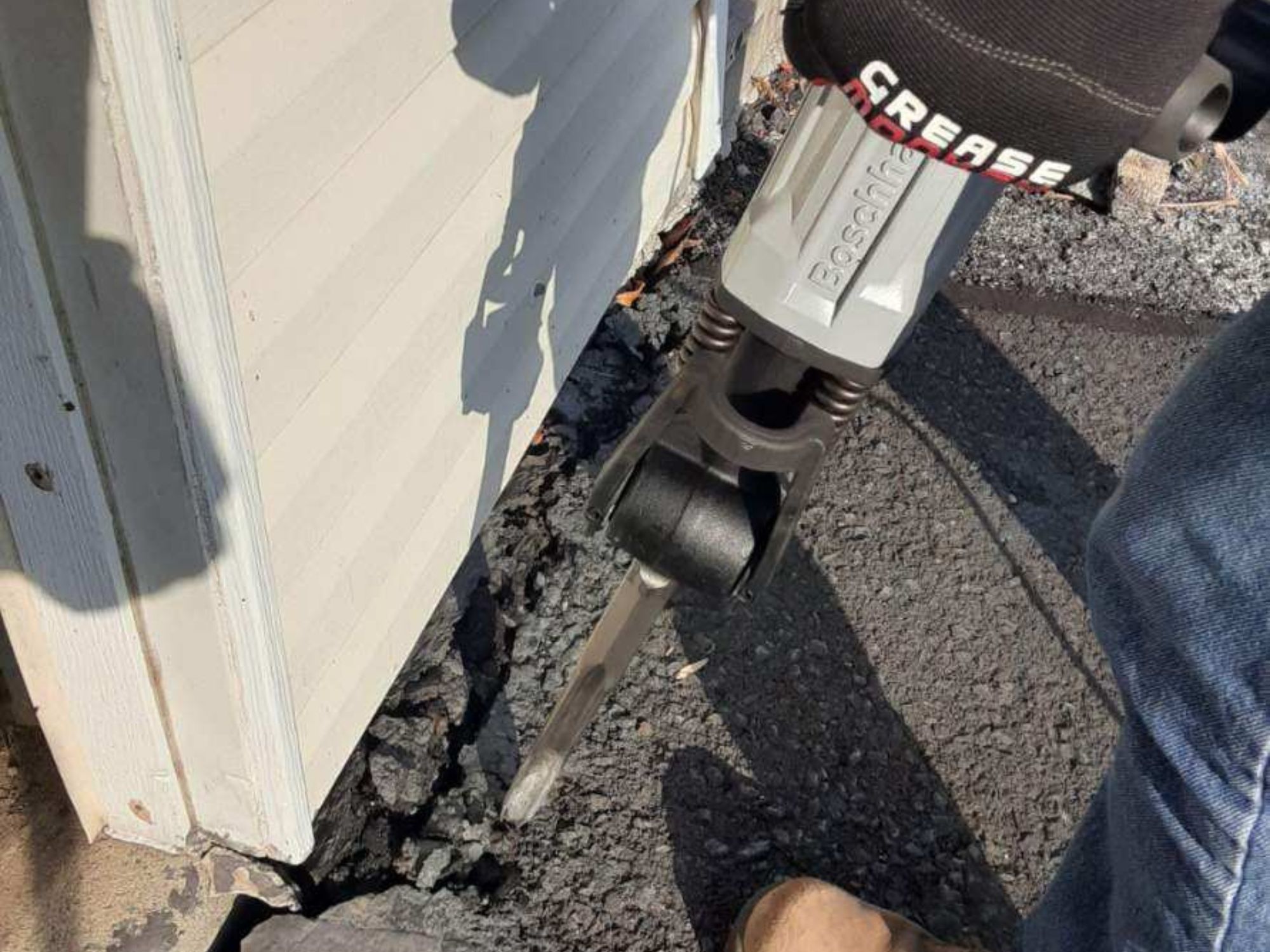
| Testing Stats | |
| Products tested | 4 |
| Time spent testing | 5 hours |
| Tests performed | 6 |
| Price range | $70 – $1,000 |
What to Consider When Choosing a Jackhammer
Jackhammers are very different tools than the claw or framing hammers that many DIYers are used to working with. It can be difficult to understand the technical jargon and the impact of various performance figures. The following section helps clarify the details provided by manufacturers to make it easier to assess how suitable each model will be for the work you need to do.
Type
There are four different types of jackhammers: hydraulic, pneumatic, gas, and electric.
- Hydraulic jackhammers are the most powerful type. They are usually attached to an excavator and use the vehicle’s hydraulic system for power.
- Pneumatic jackhammers run on large compressors and are used for industrial applications like road building and commercial demolition. Both are heavy-duty professional tools costing thousands of dollars and fall beyond the scope of this article.
- Gas-powered jackhammers are lighter but still offer good performance for the type of contractor and DIY tasks on which this list focuses. Almost all have 2-stroke engines. While many meet EPA standards for emissions, only a few meet the more stringent CARB requirements.
- Electric models can be just as powerful as gas rivals, come in greater variety, and are more environmentally friendly. Their drawback is the need for a cord. The Occupational Safety and Health Administration states that extension cords should not exceed 100 feet and that it is unsafe to “daisy-chain” them together.
Weight
The weight of a jackhammer can be a confusing figure because it can mean two different things. The first is obvious—the actual physical weight of the tool. This can vary considerably. The heavy-duty Makita jackhammer profiled above weighs more than 70 pounds, whereas the XtremepowerUS is under 20 pounds. That can make a big difference in how tiring it is to use each jackhammer.
The other way weight is expressed by manufacturers is in terms of the force, or impact energy, the tools deliver. Looking at the Makita again, it is rated as a 70-pound tool. Although often called a weight, strictly speaking, this relates to the force applied. However, not all companies use this force specification, and while it might be useful when comparing jackhammers, it isn’t as accurate as the impact ratings.
Impact Ratings
As with weight, there are two impact figures that you will want to consider. The first, impact energy, is most important in terms of the raw power delivered through the chisel. It could also be seen as the breaking force. It is given as foot-pounds, often written as ft.lbs. or ft/lbs. This can be confusing when some tools (like the Makita) give a pound rating only. For clarification, the Makita’s actual impact energy is 46.5 foot-pounds, and this is the figure that ought to be looked at when making comparisons.
Second is the impact rate, or how fast the hammer action works. This is given in blows per minute (bpm). Light-duty jackhammers often have higher revving motors than large devices, and therefore a faster impact rate. It doesn’t equate to more breaking power unless the two machines being compared are otherwise the same.
Additional Specifications and Features
Unlike small, precision tools, a jackhammer is usually a large, brute-force tool, and as such, requires careful consideration before purchasing. Taking a closer look at some important specifications and special features, listed below, can help you make the right buying decision.
- Electric jackhammers rarely run at more than 15A because that’s the maximum a standard household outlet can handle. Some use 20A. Most houses have at least a couple of these, though it is worth checking before making a purchase. Watts can vary considerably. Higher wattage basically means a more powerful motor, and so theoretically the tool is capable of working harder for longer.
- Jackhammers are known for being some of the loudest power tools, and ear protection is recommended. It can still be worth checking the decibel rating (when provided). This might be a deciding factor between two otherwise similar tools.
- Vibration is another key issue. Jackhammers vibrate—a lot. Those vibrations run through the operator’s entire body and quickly cause fatigue. Anything that reduces the effect is a bonus. Features can range from soft-grip handles to complex internal mechanisms that prevent much of the impact force from being transmitted to the user.
- Maneuverability can be a concern, and it’s not all about weight. Balance, grip, main and auxiliary handles, and controls are all worth considering.
- Speed control can be useful for those who work with a lot of different materials, although many jackhammers spend their entire life running flat out.
- It’s nice to have a range of chisels for different tasks. Some jackhammers include only one. Others offer three or four chisels. Check size if buying extras. A 1.125-inch chisel is common, but it’s not the only size available.
Safety Tips for Using Jackhammers
A jackhammer is not a dangerous tool as such, but the weight and power of the breakers can lead to injury if not handled with some care. The most important thing to do upon purchasing one is to read the owner’s manual, even if you have used similar tools before.
Pay particular attention to how to turn the tool off quickly in an emergency. Also, follow maintenance guidelines. A jackhammer that malfunctions because it hasn’t been looked after properly can cause serious safety issues.
Following these guidelines can help ensure safe use:
- Always wear appropriate clothing: strong gloves, eye protection, ear defenders, and a dust mask. Protective footwear is also a good idea. A hard hat might be necessary where heavy-duty construction work is taking place.
- When using an electric jackhammer, it should be plugged into a ground-fault circuit interrupter outlet to prevent risk from shocks. If using an extension cord, make sure it is of the appropriate gauge: If the cord gets hot while running, it is too thin and there’s a risk of fire.
- Keep children and pets away from the work area.
- Take frequent breaks. Even low-vibration jackhammers are tiring to use for long periods. If you feel tired, stop. Fatigue is often the reason for accidents. Remember proper posture to prevent back strain.
- Disconnect the power before changing chisels.
FAQs
We’ve covered the subject of jackhammers and the various performance options in considerable depth. Although we’ve reviewed the technical aspects of these powerful tools in detail, research on jackhammer purchases revealed a few questions of a more general nature. The answers to those have been provided below.
The type of hammer used for demolition can have several different names. The term “jackhammer” applies to all of them, though it is most often used for large upright tools. They are also called breaker hammers. Lighter, more manageable models might be called demolition hammers or rotary hammer drills.
The jackhammer size you need depends on the type of work you’re undertaking. The 70-pound Makita featured above is designed for heavy-duty applications like breaking up large areas of concrete or asphalt. The Bosch is a great general-purpose tool, and the XtremepowerUS is easy to handle for smaller jobs indoors or out.
The term “jackhammer” can be applied to a number of different tools. Traditionalists might argue that a jackhammer is used upright, and a demolition hammer is used horizontally. However, as can be seen above, there are a number of crossovers. Focusing on the tool’s capabilities is more important than the name it has been given.
To determine how powerful a jackhammer will be as a concrete removal tool, consider its weight. The standard rule is 10 pounds of tool for every inch of concrete. You can also consider the tool’s impact energy. Small to medium jobs require 15 to 22 foot-pounds while larger jobs require 30 to 45 foot-pounds.
Some experts recommend a continuous light spray of water at the point where the bit strikes the concrete to suppress airborne dust which can be hazardous if inhaled. Simply wetting the concrete before beginning the job is not enough. Another option is to cover the area with 6-mil polyethylene sheeting; the impact will break the concrete through the sheeting, but it will keep the dust and debris down.
Exposure to concrete dust can damage lungs so masks should always be worn on every demolition job.
Generally, removing a square foot of concrete 4 inches thick takes 2 to 5 minutes, and a 100-square-foot area 3 to 8 hours. Factors including operator experience, concrete reinforcement, and obstacles such as trees or underground pipes will influence the timing.
Meet the Tester
Jodi Webb is a DIYer who tests products with her contractor husband so readers get the advantages of both an expert’s and DIYer’s viewpoint.
Additional research provided by Bob Beacham.




